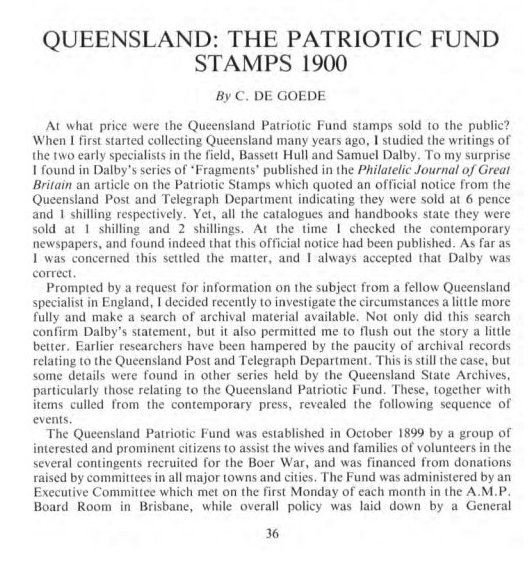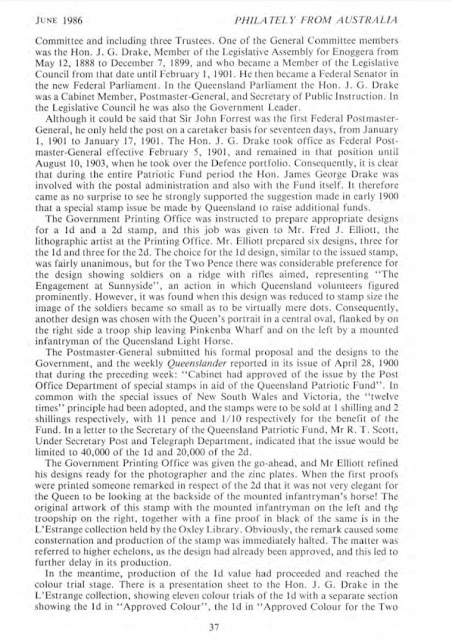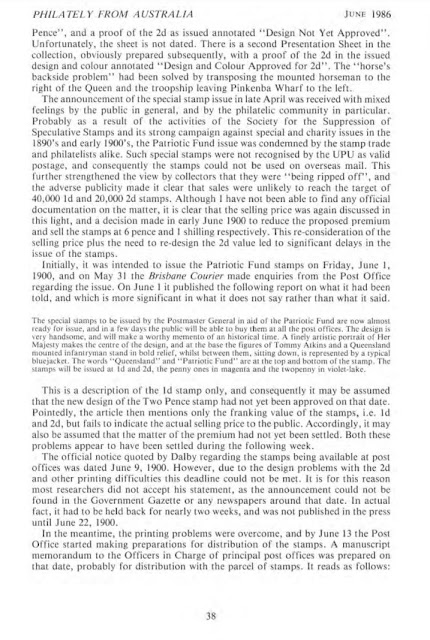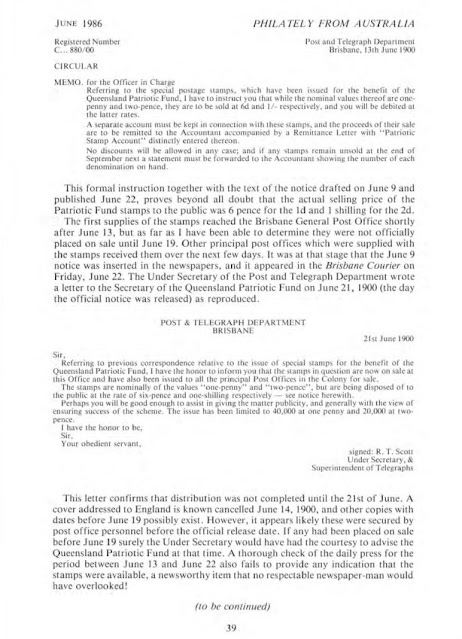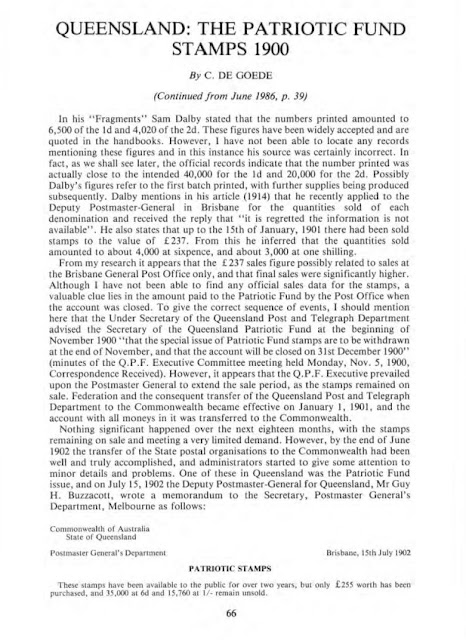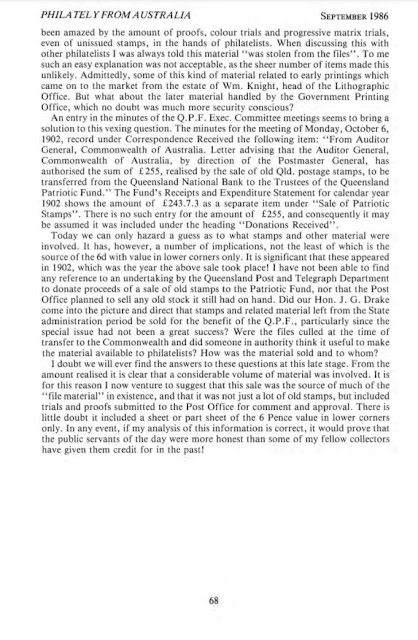An interesting and well researched article on the Queensland Boer War charity stamps by Chris de Goede published in Philately from Australia in June and September 1986
QUEENSLAND: THE PATRIOTIC FUND STAMPS 1900
By C. DE GOEDE
At what price were the Queensland Patriotic Fund stamps sold
to the public? When I first started collecting Queensland many years ago, I
studied the writings of the two early specialists in the field, Bassett Hull
and Samuel Dalby. To my surprise I found in Dalby's series of "Fragments'
published in the Philatelic Journal of Great Britain an article on the
Patriotic Stamps which quoted an official notice from the Queensland Post and
Telegraph Department indicating they were sold at 6 pence and 1 shilling respectively.
Yet, all the catalogues and handbooks state they were sold at 1 shilling and 2
shillings. At the time I checked the contemporary newspapers, and found indeed
that this official notice had been published. As far as I was concerned this
settled the matter, and I always accepted that Dalby was correct.
Prompted by a request for information on the subject from a
fellow Queensland specialist in England, I decided recently to investigate the
circumstances a little more fully and make a search of archival material
available. Not only did this search confirm Dalby's statement, but it also
permitted me to flush out the story a little better. Earlier researchers have
been hampered by the paucity of archival records relating to the Queensland
Post and Telegraph Department. This is still the case, but some details were
found in other series held by the Queensland State Archives, particularly those
relating to the Queensland Patriotic Fund. These, together with items culled
from the contemporary press, revealed the following sequence of events.
The Queensland Patriotic Fund was established in October
1899 by a group of interested and prominent citizens to assist the wives and
families of volunteers in the several contingents recruited for the Boer War,
and was financed from donations raised by committees in all major towns and
cities. The Fund was administered by an Executive Committee which met on the
first Monday of each month in the A.M.P. Board Room in Brisbane, while overall
policy was laid down by a General Committee and including three Trustees. One
of the General Committee members was the Hon. J. G. Drake, Member of the
Legislative Assembly for Enoggera from May 12, 1888 to December 7, 1899, and
who became a Member of the Legislative Council from that date until February 1,
1901. He then became a Federal Senator in the new Federal Parliament. In the
Queensland Parliament the Hon. J. G. Drake was a Cabinet Member,
Postmaster-General, and Secretary of Public Instruction. In the Legislative
Council he was also the Government Leader.
Although it could be said that Sir John Forrest was the
first Federal Postmaster- General, he only held the post on a caretaker basis
for seventeen days, from January 1. 1901 to January 17, 1901. The Hon. J. G.
Drake took office as Federal Postmaster-General effective February 5, 1901, and
remained in that position until August 10, 1903, when he took over the Defence
portfolio. Consequently, it is clear that during the entire Patriotic Fund period
the Hon. James George Drake was involved with the postal administration and
also with the Fund itself. It therefore came as no surprise to see he strongly
supported the suggestion made in early 1900 that a special stamp issue be made
by Queensland to raise additional funds.
The Government Printing Office was instructed to prepare
appropriate designs for a 1d and a 2d stamp, and this job was given to Mr. Fred
J. Elliott, the lithographic artist at the Printing Office. Mr. Elliott
prepared six designs, three for the 1d and three for the 2d. The choice for the 1d design, similar to the issued stamp, was fairly unanimous, but for the Two
Pence there was considerable preference for the design showing soldiers on a
ridge with rifles aimed, representing "The Engagement at Sunnyside",
an action in which Queensland volunteers figured prominently. However, it was
found when this design was reduced to stamp size the image of the soldiers
became so small as to be virtually mere dots. Consequently. another design was chosen
with the Queen's portrait in a central oval, flanked by on the right side a
troop ship leaving Pinkenba Wharf and on the left by a mounted infantryman of
the Queensland Light Horse.
The Postmaster General submitted his formal proposal and the
designs to the Government, and the weekly Queenslander reported in its issue of
April 28, 1900 that during the preceding week: "Cabinet had approved of
the issue by the Post Office Department of special stamps in aid of the
Queensland Patriotic Fund". In common with the special issues of New South
Wales and Victoria, the "twelve times" principle had been adopted,
and the stamps were to be sold at 1 shilling and 2 shillings respectively, with
11 pence and 1/10 respectively for the benefit of the Fund. In a letter to the
Secretary of the Queensland Patriotic Fund, Mr R. T. Scott. Under Secretary
Post and Telegraph Department, indicated that the issue would be limited to
40,000 of the Id and 20,000 of the 2d.
The Government Printing Office was given the go-ahead, and
Mr Elliott refined his designs ready for the photographer and the zine plates.
When the first proofs were printed someone remarked in respect of the 2d that
it was not very elegant for the Queen to be looking at the backside of the
mounted infantryman's horse! The original artwork of this stamp with the
mounted infantryman on the left and the troopship on the right, together with a
fine proof in black of the same is in the L'Estrange collection held by the
Oxley Library. Obviously, the remark caused some consternation and production
of the stamp was immediately halted. The matter was referred to higher
echelons, as the design had already been approved, and this led to further
delay in its production.
In the meantime, production of the 1d value had proceeded
and reached the colour trial stage. There is a presentation sheet to the Hon.
J. G. Drake in the L'Estrange collection, showing eleven colour trials of the 1d with a separate section showing the 1d in "Approved Colour", the
ld in "Approved Colour for the Two Pence", and a proof of the 2d as
issued annotated "Design Not Yet Approved". Unfortunately, the sheet
is not dated. There is a second Presentation Sheet in the collection, obviously
prepared subsequently, with a proof of the 2d in the issued design and colour
annotated "Design and Colour Approved for 2d". The "horse's
backside problem" had been solved by transposing the mounted horseman to
the right of the Queen and the troopship leaving Pinkenba Wharf to the left.
The announcement of the special stamp issue in late April
was received with mixed feelings by the public in general, and by the
philatelic community in particular. Probably as a result of the activities of
the Society for the Suppression of Speculative Stamps and its strong campaign
against special and charity issues in the 1890's and early 1900's, the
Patriotic Fund issue was condemned by the stamp trade and philatelists alike.
Such special stamps were not recognised by the UPU as valid postage, and consequently
the stamps could not be used on overseas mail. This further strengthened the
view by collectors that they were "being ripped off"', and the
adverse publicity made it clear that sales were unlikely to reach the target of
40,000 1d and 20,000 2d stamps. Although I have not been able to find any
official documentation on the matter, it is clear that the selling price was
again discussed in this light, and a decision made in early June 1900 to reduce
the proposed premium and sell the stamps at 6 pence and I shilling
respectively. This re-consideration of the selling price plus the need to
re-design the 2d value led to significant delays in the issue of the stamps.
Initially, it was intended to issue the Patriotic Fund
stamps on Friday, June 1. 1900, and on May 31 the Brisbane Courier made
enquiries from the Post Office regarding the issue. On June 1 it published the
following report on what it had been told, and which is more significant in
what it does not say rather than what it said.
The special stamps to be issued by the Postmaster General in
aid of the Patriotic Fund are now almost ready for issue, and in a few days the
public will be able to buy them at all the post offices. The design is very
handsome, and will make a worthy memento of an historical time. A finely
artistic portrait of Her Majesty makes the centre of the design, and at the
base the figures of Tommy Atkins and a Queensland. mounted infantryman stand in
bold relief, whilst between them, sitting down, is represented by a typical
bluejacket. The words "Queensland" and "Patriotic Fund" are
at the top and bottom of the stamp. The amps will be issued at 1d and 2d, the
penny ones in magenta and the two penny in violet-lake.
This is a description of the 1d stamp only, and consequently
it may be assumed, that the new design of the Two Pence stamp had not yet been
approved on that date. Pointedly, the article then mentions only the franking
value of the stamps, i.e. 1d and 2d, but fails to indicate the actual selling
price to the public. Accordingly, it may also be assumed that the matter of the
premium had not yet been settled. Both these problems appear to have been
settled during the following week.
The official notice quoted by Dalby regarding the stamps
being available at post offices was dated June 9, 1900. However, due to the
design problems with the 2d and other printing difficulties this deadline could
not be met. It is for this reason most researchers did not accept his
statement, as the announcement could not be found in the Government Gazette or
any newspapers around that date. In actual fact, it had to be held back for
nearly two weeks, and was not published in the press until June 22, 1900.
In the meantime, the printing problems were overcome, and by
June 13 the Post Office started making preparations for distribution of the
stamps. A manuscript memorandum to the Officers in Charge of principal post
offices was prepared on that date, probably for distribution with the parcel of
stamps. It reads as follows:
Post and Telegraph Department Brisbane, 13th June 1900
Registered Number C. 880/00. CIRCULAR. MEMO, for the Officer
in Charge
Referring to the special postage
stamps, which have been issued for the benefit of the Queensland Patriotic
Fund, I have to instruct you that while the nominal values thereof are one
penny and two-pence, they are to be sold at 6d and 1/- respectively, and you
will be debited at
the latter rates. A separate
account must be kept in connection with these stamps, and the proceeds of their
sale are to be remitted to the Accountant accompanied by a Remittance Letter
with "Patriotic Stamp Account" distinctly entered thereon. No discounts
will be allowed in any case; and if any stamps remain unsold at the end of
September next a statement must
be forwarded to the Accountant showing the number of each
denomination on hand.
This formal instruction together with the text of the notice
drafted on June 9 and published June 22, proves beyond all doubt that the
actual selling price of the Patriotic Fund stamps to the public was 6 pence for
the 1d and 1 shilling for the 2d.
The first supplies of the stamps reached the Brisbane
General Post Office shortly after June 13, but as far as I have been able to
determine they were not officially. placed on sale until June 19. Other
principal post offices which were supplied with the stamps received them over
the next few days. It was at that stage that the June 9 notice was inserted in
the newspapers, and it appeared in the Brisbane Courier on Friday, June 22. The
Under Secretary of the Post and Telegraph Department wrote a letter to the
Secretary of the Queensland Patriotic Fund on June 21, 1900 (the day the official
notice was released) as reproduced.
POST & TELEGRAPH DEPARTMENT BRISBANE
21st June 1900
Sir,
Referring to previous
correspondence relative to the one of special stamps for the benefit of the
Queensland Patriotic Fund. I have the honor to inform you that the stamps in
question are now on sale at this Office and have also been issued to a all the
principal Post Offices in the Colony for sale.
The stamps are nominally of the
values "one-penny" and "wo-pence", but are being disposed
of to the p public at the rate of six-pence and one-shilling respectively see
notice herewith Perhaps you will be good enough to assist in giving the matter
publicity, and generally with the view of ensuring success of the scheme. The
issue has been limited to 40,000 at one penny and 20,000 at two-pence I have
the honor to be
Sir Your obedient servant,
signed: R. T. Scott
Under Secretary, & Superintendent of Telegraphs
This letter confirms that distribution was not completed
until the 21st of June. A cover addressed to England is known cancelled June
14, 1900, and other copies with dates before June 19 possibly exist. However,
it appears likely these were secured by post office personnel before the
official release date. If any had been placed on sale before June 19 surely the
Under Secretary would have had the courtesy to advise the Queensland Patriotic
Fund at that time. A thorough check of the daily press for the period between
June 13 and June 22 also fails to provide any indication that the stamps were
available, a newsworthy item that no respectable newspaper-man would have
overlooked!
In his "Fragments" Sam Dalby stated that the
numbers printed amounted to 6,500 of the 1d and 4,020 of the 2d. These figures
have been widely accepted and are quoted in the handbooks. However, I have not
been able to locate any records mentioning these figures and in this instance
his source was certainly incorrect. In fact, as we shall see later, the
official records indicate that the number printed was actually close to the
intended 40,000 for the 1d and 20,000 for the 2d. Possibly Dalby's figures
refer to the first batch printed, with further supplies being produced
subsequently. Dalby mentions in his article (1914) that he recently applied to
the Deputy Postmaster-General in Brisbane for the quantities sold of each
denomination and received the reply that "it is regretted the information
is not available". He also states that up to the 15th of January, 1901
there had been sold stamps to the value of £237. From this he inferred that the
quantities sold amounted to about 4,000 at sixpence, and about 3,000 at one
shilling.
From my research it appears that the £237 sales figure
possibly related to sales at the Brisbane General Post Office only, and that
final sales were significantly higher. Although I have not been able to find
any official sales data for the stamps, a valuable clue lies in the amount paid
to the Patriotic Fund by the Post Office when the account was closed. To give
the correct sequence of events, I should mention here that the Under Secretary
of the Queensland Post and Telegraph Department advised the Secretary of the
Queensland Patriotic Fund at the beginning of November 1900 "that the
special issue of Patriotic Fund stamps are to be withdrawn at the end of
November, and that the account will be closed on 31st December 1900"
(minutes of the Q.P.F. Executive Committee meeting held Monday, Nov. 5, 1900,
Correspondence Received). However, it appears that the Q.P.F. Executive
prevailed upon the Postmaster General to extend the sale period, as the stamps
remained on sale. Federation and the consequent transfer of the Queensland Post
and Telegraph Department to the Commonwealth became effective on January 1,
1901, and the account with all moneys in it was transferred to the
Commonwealth.
Nothing significant happened over the next eighteen months,
with the stamps remaining on sale and meeting a very limited demand. However,
by the end of June 1902 the transfer of the State postal organisations to the
Commonwealth had been well and truly accomplished, and administrators started
to give some attention to minor details and problems. One of these in
Queensland was the Patriotic Fund issue, and on July 15, 1902 the Deputy
Postmaster-General for Queensland, Mr Guy H. Buzzacott, wrote a memorandum to
the Secretary, Postmaster General's Department, Melbourne as follows:
Commonwealth of Australia State of Queensland
Postmaster General's Department
PATRIOTIC STAMPS
Brisbane, 15th July 1902
These stamps have been available
to the public for over two years, but only £255 worth has been purchased, and
35,000 at 6d and 15,760 at 1/- remain unsold
The stamps are still for sale,
and the amount received so far has been placed to suspense account in the
Queensland National Bank.
I recommend that the account may
now be closed, and the remaining stamps be destroyed in the presence of an
Audit Inspector.
I may add that 60 of each
denomination have been treated as Specimens.
signed: Guy H. Burzacott Deputy Postmaster General
Referred to the Secretary, Postmaster General's Department,
Melbourne
This memorandum was received in Melbourne and endorsed as follows.
1 In first instance ask Brisbane by circ. for the papers in connection with opening of the are referred to
2. Recommend accordingly, Specimen sheets (2) of each, lightly postmarked, to be sent to this office
3. Memo to Brisbane 29/7/02
Although I have not been able to find an actual date of
withdrawal, we may assume from the above that the stamps were withdrawn and the
account closed sometime in August 1902. Dalby and others reported that unsold
remainders of the stamps were burned, and this probably took place about the
same time. Having the above information gives us some guide as to the
quantities actually printed and sold.
It was only at the Q.P.F. Executive Committee meeting of
Monday, Nov. 3, 1902, that the Secretary could record in the minutes under
Correspondence Received that he had "received a letter from the Deputy
Postmaster General, Commonwealth of Australia, forwarding a cheque for
£243.7.3, being the net proceeds of the sale of postage stamps specially issued
in aid of the Queensland Patriotic Fund". This figure now gives us a
better idea of the quantities sold. Dalby's view that sales of the id were
larger than those of the 2d was no doubt correct. This leaves us to make some
simple calculations.
If we take 2d sales at 3,600, the net proceeds from the sale
of these stamps would have been 3,600 times ten pence, which equals £150. This
leaves £93.7.3 as the net proceeds from the 1d stamps. On the basis of a net
benefit of five pence per stamp. this latter figure represents the net proceeds
of 4,481 1d stamps. Taking comparative rarity into account, these sales figures
seem to balance reasonably well, and they also fit in with the remainders
quoted in the 15 July 1902 memorandum to Melbourne. Obviously, when it became
known the stamps were to be withdrawn additional sales were made to increase
the total revenue above the £255 quoted. To sum up, nearly 40,000 of the 1d and
20,000 of the 2d were printed, of which 4,481 of the 1d and 3,600 of the 2d
were sold at a price of 6 pence and 1/- respectively.
The above resume shows that Queensland's first and only
venture into a charity issue was somewhat of a comedy of errors! Small wonder
the issue was ignored by: collectors and the trade for many years. In fact,
Stanley Gibbons refused to catalogue them until 1928! However, our friend
Samuel Dalby was perceptive as ever when he concluded his article in 1914 with
the following sentence: "The two- examples have hitherto been eschewed by
collectors of Queensland stamps, but as they are the only commemoratives of
this Colony, it is more likely that in the future a collection will be deemed
incomplete without them." And that is certainly the situation today. It is
to be hoped that now the full facts are known about the stamps, cataloguers
will correct the erroneous information they have given for so many years.
Unexpectedly, my research into the history of the Queensland
Patriotic Fund issue yielded an additional bonus! As a long-time collector of
Queensland I have always been amazed by the amount of proofs, colour trials and
progressive matrix trials, even of unissued stamps, in the hands of
philatelists. When discussing this with other philatelists I was always told
this material "was stolen from the files". To me such an easy
explanation was not acceptable, as the sheer number of items made this
unlikely. Admittedly, some of this kind of material related to early printings
which came on to the market from the estate of Wm. Knight, head of the
Lithographic Office. But what about the later material handled by the
Government Printing Office, which no doubt was much more security conscious?
An entry in the minutes of the Q.P.F. Exec, Committee
meetings seems to bring a solution to this vexing question. The minutes for the
meeting of Monday, October 6, 1902, record under Correspondence Received the
following item: "From Auditor General, Commonwealth of Australia. Letter
advising that the Auditor General, Commonwealth of Australia, by direction of
the Postmaster General, has authorised the sum of £255, realised by the sale of
old Qld. postage stamps, to be transferred from the Queensland National Bank to
the Trustees of the Queensland Patriotic Fund." The Fund's Receipts and
Expenditure Statement for calendar year 1902 shows the amount of £243.7.3 as a
separate item under "Sale of Patriotic Stamps". There is no such
entry for the amount of £255, and consequently it may) be assumed it was included
under the heading "Donations Received".
Today we can only hazard a guess as to what stamps and other
material were involved. It has, however, a number of implications, not the
least of which is the source of the 6d with value in lower corners only. It is
significant that these appeared in 1902, which was the year the above sale took
place! I have not been able to find any reference to an undertaking by the
Queensland Post and Telegraph Department to donate proceeds of a sale of old
stamps to the Patriotic Fund, nor that the Post Office planned to sell any old
stock it still had on hand. Did our Hon. J. G. Drake come into the picture and
direct that stamps and related material left from the State administration
period be sold for the benefit of the Q.P.F., particularly since the special
issue had not been a great success? Were the files culled at the time of
transfer to the Commonwealth and did someone in authority think it useful to
make the material available to philatelists? How was the material sold and to
whom?
I doubt we will ever find the answers to these questions at
this late stage. From the amount realised it is clear that a considerable
volume of material was involved. It is for this reason I now venture to suggest
that this sale was the source of much of the "file material" in
existence, and that it was not just a lot of old stamps, but included trials
and proofs submitted to the Post Office for comment and approval. There is
little doubt it included a sheet or part sheet of the 6 Pence value in lower
corners. only. In any event, if my analysis of this information is correct, it
would prove that the public servants of the day were more honest than some of
my fellow collectors have given them credit for in the past!
